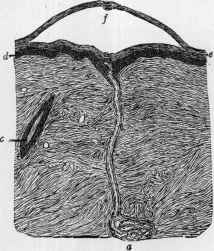| MEDICAL INTRO |
| BOOKS ON OLD MEDICAL TREATMENTS AND REMEDIES |
THE PRACTICAL |
ALCOHOL AND THE HUMAN BODY In fact alcohol was known to be a poison, and considered quite dangerous. Something modern medicine now agrees with. This was known circa 1907. A very impressive scientific book on the subject. |
DISEASES OF THE SKIN is a massive book on skin diseases from 1914. Don't be feint hearted though, it's loaded with photos that I found disturbing. |
SUDAMEN
Synonyms.—Miliaria crystallina; Fr., Miliare crystalline; Ger., Schweissfriese-
lausschlag.
Definition.—A noninflammatory ephemeral disorder of the
sweat-glands, characterized by pinpoint to pin-head-sized, discrete
but usually thickly set, superficial, translucent, whitish vesicles.
Symptoms.—The eruption makes its appearance suddenly, the
lesions developing irregularly or in crops, and is seen most frequently
and most abundantly on the trunk, especially anteriorly; it may, how
ever, be seen over other parts, and occasionally over the entire surface.
Its appearance seems to be most frequent and most abundant where
the epidermis is thin. The lesions are discrete, although often closely
crowded, but with no tendency to coalescence, and appear as whitish
or pearl-colored, translucent, very minute elevations, which bear re
semblance to small dewdrops. They are noninflammatory, without
hyperemia or areola, and never assume such characters. The contents
remain clear, never becoming purulent, and quickly or gradually disap
pear by absorption or evaporation, the epidermal covering disappearing
by desquamation, which, however, is necessarily extremely slight. There
1 The several observations here quoted are from Duhring, Diseases of the Skin,
third ed., p. 144, where literature references can be found.
2Panceri, La France Méd., March 31, 1877; Cincinnati Lancet and Observer, May,
1877, p. 504.
3 Quoted in Carpenter’s Physiology, 1876, p. 550.
4 Marsh, Provincial Med. and Surg. Jour., 1842, vol. iv, p. 170.
5 Supplement to Brit. Med. Jour., Jan. 1, 1891 (quoted by Crocker).
SUDAMEN I083
is rarely exhibited any tendency to spontaneous rupture. While the
whole process may come to an end in several days to a week, the disease
may be more prolonged by the appearance of new lesions. There are no
subjective symptoms.
Etiology and Pathology.—The eruption is seen in those
gravely debilitated, and especially when associated with high fever.
It therefore often occurs in the course of typhus, typhoid, rheumatic,
puerperal, and hectic fevers; and is probably due indirectly to nerve
disturbance. The investigations of Robinson, Haight, and Török show
the lesion to be formed between the lamellae of the corneous layers,
usually the upper layers.
The formation of the lesion
is thought to be due to
some change in the char
acter of the epithelial cells
of the corneous layer, prob
ably from high tempera
ture, causing a blocking of
the surface outlet and the
escape of the sweat from
the sweat-duct into the sur
rounding tissue of the cor
neous layer; the contents of
the lesion consist of pure
sweat (Robinson).
Diagnosis.—The
characters of the eruption,
with the associated general
condition, are sufficiently
distinct and pronounced as
to make the diagnosis a
matter of no difficulty.
The absence of all hyper-
emia and other signs of in
flammation serves to dis
tinguish it from miliaria
and from vesicular eczema. The lesions of hydrocystoma are somewhat
similar, but much larger, deeper seated, upon the face, and there is no
associated febrile or cachectic factor.
Prognosis and Treatment.—The condition is usually evanes
cent, rarely lasting for more than several days, but there may be recurrent
crops. The eruption has no prognostic value as to the disease in the
course of which it appears. Treatment is often scarcely necessary, but
the parts may be sponged with diluted alcohol, one part alcohol to several
parts water, and a simple dusting-powder, such as powdered starch,
lycopodium, or zinc oxid, or a mixture of these, applied; or the dusting-
powder may be used alone.

Fig. 266.—Sudamen, showing vesicle (f) con
taining pure sweat, with wall of upper lamellae of
corneous layer (e) and sweat orifice, or pore, at b;
at lower part of vesicle the sweat-duct leading into
the corium to the sweat-gland (a); d, rete; c, hair-
follicle. The rete and corium are normal (courtesy
of Dr. A. R. Robinson).
But first, if you want to come back to this web site again, just add it to your bookmarks or favorites now! Then you'll find it easy!
Also, please consider sharing our helpful website with your online friends.
BELOW ARE OUR OTHER HEALTH WEB SITES: |
Copyright © 2000-present Donald Urquhart. All Rights Reserved. All universal rights reserved. Designated trademarks and brands are the property of their respective owners. Use of this Web site constitutes acceptance of our legal disclaimer. | Contact Us | Privacy Policy | About Us |